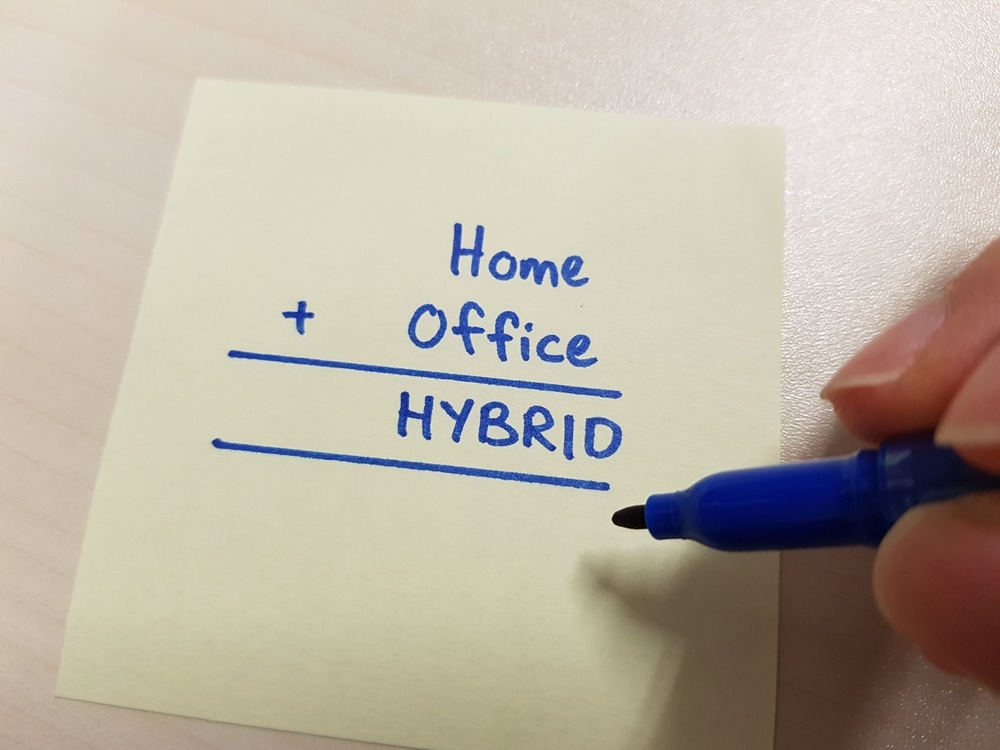Working in sweatpants at home one day and holding meetings over cappuccinos the next—that’s the beauty of hybrid work. But this flexibility also comes with new challenges. How do you stay focused when you’re constantly switching between environments? How do you avoid burnout, distractions, or losing track of your priorities? In this guide, we’ll break down practical tips to help you boost your hybrid work productivity, no matter where you set up for the day.
What Is Hybrid Work, Really?
Hybrid work is the blend of working remotely and working from a fixed location like an office, coworking space, or even your favorite neighborhood café. It offers a flexible structure that lets employees split their time between home and on-site locations—sometimes on a fixed schedule, other times based on individual preference or project needs.
One day, you might be taking back-to-back Zoom calls in sweatpants from your kitchen table. The next, you’re catching up with coworkers at a conference room whiteboard or finishing a report over oat milk lattes at your go-to coffee shop. Hybrid work is not about choosing either remote or office—it’s about creating a balanced mix that supports productivity, collaboration, and well-being.
This model gained massive popularity after 2020, when the pandemic forced a global shift in how work gets done. Many businesses realized they could maintain, or even increase, productivity without requiring people to be in the office five days a week. Employees, on the other hand, discovered they could reclaim commute hours, find more focus at home, and enjoy better work-life balance.
Challenges To Face
But improving hybrid work productivity isn’t without its challenges. Without the physical structure of a daily commute and a fixed desk, it’s easy to feel untethered. Juggling different environments means constantly adapting your routines, staying self-motivated, and finding new ways to stay connected to your team.
The traditional 9-to-5 mindset—clock in, clock out, go home—doesn’t quite fit anymore. And in many ways, that’s a good thing. Hybrid work encourages us to be more intentional with how we manage our time, energy, and space. It pushes us to rethink what productivity really looks like.
Still, flexibility without structure can lead to burnout, decision fatigue, or feeling like you’re always “on.” That’s why building a thoughtful hybrid work routine is so important—not just for getting things done, but for protecting your focus and well-being.
So, how do you stay sharp and efficient while jumping between home, office, and third places like coffee shops? How do you make the most of the freedom without losing your momentum?
Let’s get into the real strategies that help you thrive in this new, flexible world of work.

1. Design Your Week (Not Just Your Day)
One of the best things you can do for hybrid work productivity is to plan your week in advance. Instead of reacting to meetings and tasks as they pop up, block out time for specific types of work based on where you’ll be.
- Monday at home? Great for deep focus work and planning.
- Tuesday in the office? Schedule collaborative meetings or brainstorming sessions.
- Thursday at a café? Tackle lighter tasks like emails or content writing.
When you align your work with the setting, you’re less likely to feel overwhelmed—and more likely to get things done efficiently.
Pro Tip: Try the “Anchor Day” method. Pick one or two days each week to always be in the same location. This gives your week some structure, which improves both focus and consistency.
2. Set a Strong Start (Wherever You Are)
How you begin your day sets the tone. Whether you’re working from your kitchen table or a shared desk downtown, start with a solid morning ritual that gets you into “work mode.”
This could be:
- A short walk to simulate a commute
- A cup of coffee followed by a review of your top 3 priorities
- A quick journaling session or 10-minute meditation
The goal is to send your brain a signal: it’s time to focus. These small rituals can dramatically boost your mindset and hybrid work productivity.
3. Create “Zones” for Focus
Distraction is the enemy of productivity—and it shows up differently depending on where you are. At home, it might be laundry. At a café, it could be background chatter or a flaky Wi-Fi connection.
That’s why it helps to create focus zones. These aren’t just physical areas, but also mental rules.
- At home, pick a specific chair or desk that you only use for work.
- In a café, wear noise-canceling headphones or use a focus playlist.
- At the office, find a quiet corner for deep work sessions.
Train your brain to associate these zones with concentration. You’ll waste less time switching gears and stay in the zone longer.
4. Use the 3-Location Rule
One easy hack to avoid decision fatigue in hybrid work is to limit your weekly locations. Bouncing between too many places makes it harder to settle into routines or manage expectations with coworkers.
Here’s how the 3-Location Rule works:
- Choose 1 primary home workday
- Choose 1 in-office or coworking day
- Choose 1 flexible day (coffee shop, library, etc.)
This gives you variety without chaos—ideal for improving hybrid work productivity over time.
5. Master Your Tools and Tech
In hybrid work, your devices and apps are your coworkers. When they’re organized, you’re organized. But when your tabs, files, and meetings are a mess, so is your day.
- Calendar hygiene: Block focus time and set clear meeting boundaries
- Cloud storage: Use Google Drive, Notion, or Dropbox to keep files in sync across devices
- Task managers: Try apps like Todoist, Asana, or Trello to keep track of work in progress
- Status updates: Use Slack or Teams to communicate availability, especially on flexible location days
Make your tools work for you, not against you. When you don’t waste time hunting for documents or chasing reminders, your output (and sanity) improves.
6. Communicate Like a Pro
Communication is everything in a hybrid setup. People can’t see you at your desk, so being clear and consistent with updates is key. It helps manage expectations and builds trust.
- Let your team know when and where you’re working
- Use calendar notes or Slack statuses like “Working from café – focus mode”
- Share end-of-day updates, even short ones, to keep things transparent
This simple communication rhythm not only improves collaboration—it also reduces interruptions, allowing you to protect your productive hours.
7. Know When to Log Off
One of the sneakiest problems with hybrid work is the blur between “work” and “not work.” Especially when home and work exist in the same space. Over time, this can lead to burnout, even if you’re technically working fewer hours.
To keep your energy up:
- Set an end-of-day routine: Log off, close your laptop, and step outside if possible
- Have a shutdown ritual: Write down what you completed and what’s on deck for tomorrow
- Use physical cues: Change out of your work clothes or dim the lights to signal “off time”
Taking breaks, protecting evenings, and honoring rest are all part of maintaining long-term hybrid work productivity.
8. Embrace the Freedom—With Boundaries
One of the biggest perks of hybrid work is freedom. You can design a schedule that fits your energy levels, your lifestyle, and even your hobbies. But freedom without boundaries leads to chaos.
So set some ground rules:
- Don’t check email before breakfast
- Keep one weekend day work-free
- Don’t schedule meetings back-to-back all day long
These small boundaries give you the space to thrive. Hybrid work is meant to empower you—not drain you.
9. Optimize for Energy, Not Just Time
We often think productivity is about managing time. But energy is just as important. Some people do their best work early in the morning, others peak mid-afternoon. Pay attention to your natural rhythms.
If you’re an early bird, do deep work before 10 a.m., then save lighter tasks for later. If you hit your stride after lunch, don’t force 8 a.m. calls unless necessary.
Hybrid work gives you the flexibility to work with your energy instead of against it. And that’s one of the best ways to improve hybrid work productivity without burning out.
10. Keep Experimenting and Adjusting
There’s no one-size-fits-all approach to productivity, especially in a hybrid world. What works for you in summer might not work in winter. What fits your energy today might feel off next month. And that’s okay.
Check in with yourself weekly:
- Are you staying focused during work blocks?
- Do you feel more energized at home or in a café?
- Are your tools and routines still working for you?
Small tweaks make a big difference. The beauty of hybrid work is that you get to adjust and evolve your setup until it truly works for your life—not just your job.
Mastering hybrid work productivity is less about finding the perfect app or routine—and more about learning what works best for you in each setting. It’s about building intentional habits, respecting your energy, and giving yourself the structure to thrive across different environments.
So whether you’re logging in from a quiet home office or typing away in a bustling café, remember: with the right mindset and systems, productivity can follow you anywhere.





